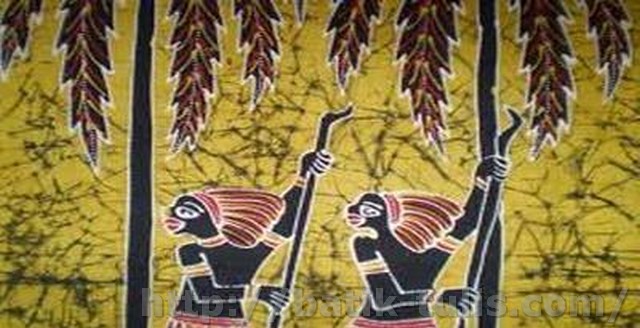It’s not complete after a visit to the Land of Cenderawasih, without bringing a souvenir. Many types of unique souvenirs are available in Papua. Starting from a necklace of pig fangs, crocodile nails, finger of paradise, noken (traditional bag made of bark / orchid), to koteka.
However, on the other hand, Indonesia is very famous for the diversity of batik. Like batik in Papua. The image of the bird of paradise becomes the identity of each batik motif from the land of Papua. When compared with batik motifs from other areas on the island of Java, Papua batik has a striking difference in motifs, which tend to have a darker color and the Papua batik motifs that are formed consist of many images of Papua statues and also use sacred symbols in the form of carvings.
The most popular Papua batik is the Asmat batik motif. The color of the batik is more brown with a combination of earth and terakota colors.

Another Papua Batik Motifs is the bird of paradise batik motif,

Kamoro batik Motif with a standing statue symbol,

Sentani Batik Motif which has a characteristic picture of a circular log groove with only one or 2 colors.

Papua batik motifs developed with a touch of gold lines are commonly known as prada batik.

Tifa Honai Batik Motif, This batik has a deep philosophical meaning. If translated, this motif means a house of happiness, namely a house filled with happiness. Inspired by many things that exist in the land of Papua such as springs, beautiful nature, and others.

Similar to other batik-producing areas that have batik production centers, Papua also has a batik center located in the city of Jayapura, West Papua Province. The process of making batik in Papua is divided into 2, namely the women doing the written batik and the men doing the stamped batik. The batik cloth used for making Papua Batik is cotton and silk. The production of batik mostly uses cotton, due to the hot weather in Papua. In terms of coloring, initially using natural dyes from areca nut, which later shifted to synthetic dyes due to the fast production demand. There are several Papuan Batik fabrics that are still produced on the island of Java and then sold in Papua. Most likely it was done to reduce production costs.

Papua batik is now much more popular than when it first appeared in the 1985s. At that time, the Indonesian government received assistance from the United Nations, represented by The United Nations Development Program (UNDP) in terms of empowering eastern Indonesian culture.
Papua batik has penetrated the European market share, this is evidenced by Jimmy Afaar who is able to make original Papua batik. At first he started his career as an assistant designer in the country. Next, he tried to make a model of batik clothes and his own batik motifs. Until finally Jimmy Afaar managed to dismantle the dominance of Javanese batik. This success made Mr. Joko Widodo and Mrs. Iriana Widodo interested in wearing batik with the “Port Numbay” brand for state events.
The diversity of Indonesian batik will be more complete with this Papua Batik. Even though from a historical perspective, Papuans are not as familiar with batik culture and techniques as people on the island of Java, but now Papuan batik centers are starting to grow along with the development of Papua Batik. We must be proud and participate in preserving and introducing it to the next generation and being guided so that it can be more competitive with other national batik.
Bibliography of Papua Batik History
- Pemerintah provinsi Papua Barat, http://www.papuabaratprov.go.id/
- Sumber berbagai Berita Nasional dengan kata kunci “batik” dated February 26, 2015